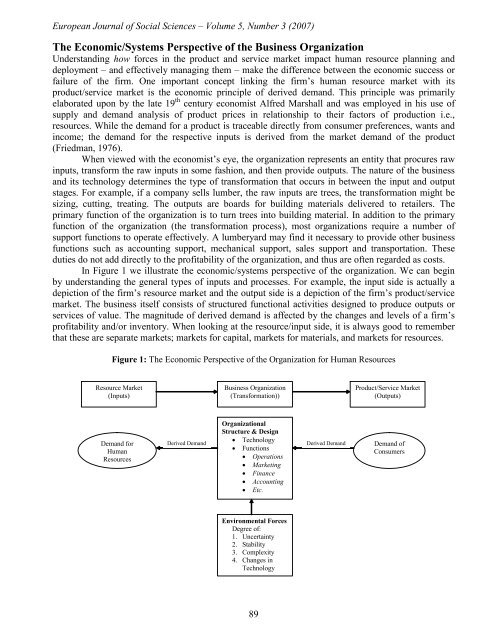european journal of social sciences issn: 1450-2267 - EuroJournals
european journal of social sciences issn: 1450-2267 - EuroJournals
european journal of social sciences issn: 1450-2267 - EuroJournals
Create successful ePaper yourself
Turn your PDF publications into a flip-book with our unique Google optimized e-Paper software.
European Journal <strong>of</strong> Social Sciences – Volume 5, Number 3 (2007)<br />
The Economic/Systems Perspective <strong>of</strong> the Business Organization<br />
Understanding how forces in the product and service market impact human resource planning and<br />
deployment – and effectively managing them – make the difference between the economic success or<br />
failure <strong>of</strong> the firm. One important concept linking the firm’s human resource market with its<br />
product/service market is the economic principle <strong>of</strong> derived demand. This principle was primarily<br />
elaborated upon by the late 19 th century economist Alfred Marshall and was employed in his use <strong>of</strong><br />
supply and demand analysis <strong>of</strong> product prices in relationship to their factors <strong>of</strong> production i.e.,<br />
resources. While the demand for a product is traceable directly from consumer preferences, wants and<br />
income; the demand for the respective inputs is derived from the market demand <strong>of</strong> the product<br />
(Friedman, 1976).<br />
When viewed with the economist’s eye, the organization represents an entity that procures raw<br />
inputs, transform the raw inputs in some fashion, and then provide outputs. The nature <strong>of</strong> the business<br />
and its technology determines the type <strong>of</strong> transformation that occurs in between the input and output<br />
stages. For example, if a company sells lumber, the raw inputs are trees, the transformation might be<br />
sizing, cutting, treating. The outputs are boards for building materials delivered to retailers. The<br />
primary function <strong>of</strong> the organization is to turn trees into building material. In addition to the primary<br />
function <strong>of</strong> the organization (the transformation process), most organizations require a number <strong>of</strong><br />
support functions to operate effectively. A lumberyard may find it necessary to provide other business<br />
functions such as accounting support, mechanical support, sales support and transportation. These<br />
duties do not add directly to the pr<strong>of</strong>itability <strong>of</strong> the organization, and thus are <strong>of</strong>ten regarded as costs.<br />
In Figure 1 we illustrate the economic/systems perspective <strong>of</strong> the organization. We can begin<br />
by understanding the general types <strong>of</strong> inputs and processes. For example, the input side is actually a<br />
depiction <strong>of</strong> the firm’s resource market and the output side is a depiction <strong>of</strong> the firm’s product/service<br />
market. The business itself consists <strong>of</strong> structured functional activities designed to produce outputs or<br />
services <strong>of</strong> value. The magnitude <strong>of</strong> derived demand is affected by the changes and levels <strong>of</strong> a firm’s<br />
pr<strong>of</strong>itability and/or inventory. When looking at the resource/input side, it is always good to remember<br />
that these are separate markets; markets for capital, markets for materials, and markets for resources.<br />
Figure 1: The Economic Perspective <strong>of</strong> the Organization for Human Resources<br />
Resource Market<br />
(Inputs)<br />
Demand for<br />
Human<br />
Resources<br />
Business Organization<br />
(Transformation))<br />
Organizational<br />
Structure & Design<br />
Derived Demand<br />
•<br />
•<br />
Technology<br />
Functions<br />
Derived Demand<br />
• Operations<br />
• Marketing<br />
• Finance<br />
• Accounting<br />
• Etc.<br />
Environmental Forces<br />
Degree <strong>of</strong>:<br />
1. Uncertainty<br />
2. Stability<br />
3. Complexity<br />
4. Changes in<br />
Technology<br />
89<br />
Product/Service Market<br />
(Outputs)<br />
Demand <strong>of</strong><br />
Consumers

















